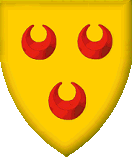|
The History of the Seton-name,
and the Carolingian Lineage of the House of Seton - The House of
Boulogne

The
manuscript at the British Museum from the 16th century
it states that "their surnam came home with King Malcolme Camoir foorth of
Ingland". Chalmers in his "Caledonia" states that the
first Setons were members of a Norman (Flemish)
family named "Say" (which was incorrect), and that they
obtained from David I land in East Lothian which were
called Sey-tun. Sir Richard Maitland of Lethington wrote
a "Historie or Chronicle of the Hous and Surename of
Seytoun" down to the year 1559, wrote that King Malcolm
Canmore "gaif to the predecessour and forebear of my
Lord Seytoun the surename of Seytoun... appearandlie be
ressoun that the gentilman... possessit the landis of
Seytoun for the tyme... thay landis ar callit Seytoun
for ane grit caus, becaus thay ly hard upon the Sey cost
and the Toun thairof is neir to the Sey."
While Maitland of
Lethington had reference to the East Lothian lands of
the family as being the originator for King Malcolm's
giving of the family name, it was in fact the King's
referring to the Northumberland lands of Staithes, the
secret port or Sea-town there, for which the King made
reference to and thence we had given likewise to the
lands in East Lothian as a result. The mark of
honour however, being given the name to the family by
the King has never been forgotten and is maintained to
this day.
It was
during the reign of King David I that the Seton Family firmly established
themselves in Scotland. They had previously settled in what was known as the sea-town of Staithes in Northumbria, a small hidden village in a cleft in the
cliffs, later called Seaton-Staithes and now simply known as
Staithes. Before that the family was previously known as
de Lens, of the House of Boulogne and seniors of the ancient Carolingian line
descended from the Emperor Charlemagne from the eldest son of Count Lambert de
Lens from his first marriage. It was Count Lambert's eldest son, Seier de
Lens who held lands in both Northumbria and later in Scotland. It appears
that Seier's Christian name is unknown, for Seier is the old French name for
Baron (Seigneur), however his brother was called Walter, or Walcher.
The
family name therefore, simply means "the town by the sea", which chronicler's
have erroneously assumed to mean that of Seton in East Lothian:
which lands received their name from the family, not given
it to them, and is the reason why the family were known as Seton
OF Seton, and not "Seton of that Ilk". Whereas
when a family
took their name from the lands, they were known as, "of that Ilk",
however when they gave their name to the lands, then the previous
applied and the family were known as being "of...". It was a
small point in Scotch etiquette, but one habitually overlooked by
English-cultured historians.
There
is no correct method on how to write the family name, however, it should be pointed out that
the S-E-T-O-N version is acknowledged as the
Scots version, and the preferred traditionally accepted version; the
S-E-A-T-O-N
being the Anglized or British version; The
S-E-E-T-O-N version seems to have been used mostly in Aberdeenshire and
in Ireland predominantly (as per the Seeton's of Nova Scotia of
the family of Seton of Barnes), though periodically found across Britain; and the
S-E-Y-T-O-U-N form is almost certainly amongst the oldest and
found in Scots documents.
The following
example of Scots writing from the 17th century serves
to illustrate the language which gave rise to the various spellings and is as follows:
Maister Jhone Forbes, (Master John Forbes)
maist worthie of credeit, (most worthy of credit)
Yit came thair neiuer to me sik a greiff in hairt and minde, as I reasued be yiour
heighness sould suspect ony sik thing off me.
It has wounded me sua, that it has putt me fra all other thocht or cair;
for as I wald think myself onwordie to be leiuand, gif I haid committed sa filthe
an errour, sua man I disdane baith my lyff and haill estaitt, sa lang as I am
in feare my maist gracious souerane has onye suspicion I be onye wayis giltie
of sa abominabill crime.
Chancellor Alexander Seton, to his
King, James VI and I, 1604.
Other
Variances from
Latin, Continental and Scots/Anglo corruptions include:
Setoniis, Sietoun, Seiton, Saytoun, Seytoune, Seyton, Setoune, Settoun, Saiton,
Setan and, Ventoun,
Wintoniensi, Wintoniensis or Wintoniae
for Winton,
which in England was called after 'Winchester'.
The Carolingian Lineage of the
House of Seton
Boulogne was originally named Gesoriacum and probably also
to be identified with
Portus Itius. By the
4th century Boulogne was known to the
Romans as Bononia and served as the major port
connecting the rest of the empire to
Britain. The emperor
Claudius used this town as his base for the
Roman invasion of Britain, in AD
43, and
until 296
it was the base of the
Classis britannica.
Like so
many other pedigrees, the Norman origin offered for the Seton
family is
careless nonsense. As
their own distinctive crescents show, Seier de Seton and his brother Walter
sprang from a second son of the House of Boulogne. Known in their Flemish
homeland as Seier and Walter de Lens, they were sons of Count Eustace I’s second
son, Count Lambert de Lens from his first wife, and whose daughter by a second marriage (to the sister
of William the Conqueror) was the Countess Judith, mother of Scotland’s Queen
Maud. With the previous Flemish ties to the ruling House in Scotland and in
Northumbria, both Seier and his brother were one of many that
were invited to come and settle in Scotland by King Malcolm III,
of the Alpin line.
The
Flemish-Boulonnaise enjoyed a much respected status throughout
Europe as a result of their lineage in the Empirical-French Monarchy, as
well as those of others, and inter-marriages between Flanders
and the courts in Scotland and Northumbria had reached their
zenith when Judith, daughter of Lambert of Lens from his second
marriage to Adele of Normandy, (sister of Duke William, later
King William I), married Waltheof of Northumberland, Earl of
Huntingdon. Their oldest daughter, Maud, married David of
Scotland (son of King Malcolm III) who became Earl of Huntingdon
and later King David I of Scotland.
The Flemish
influence at the Scottish court cemented their presence there,
coupled with service to the Royal household, and which tradition
was continued by Seier’s eldest son, Walter de Lens, or Walter the Fleming as he is
described in Domesday. Although he had his chief English home at Wahull (now called Odell)
in Bedfordshire, it was on the Firth of Forth as heir there of his father Seier
(where he
was called Dougall or "the dark stranger", a nickname which was also
given to his own son Walter, and duly recorded by the family’s first official
chronicler, Sir Richard Maitland of Lethington, in 1554), that he concentrated
his principal efforts. With the estates of Boulogne and
Lens passing to more senior family, the brother's Seier and
Walter (Walcher) became de Seaton/Seton and le
Flandrensis/Fleming, respectively in Britain. Seier's
line founded the Houses of Seton and Oliphant, and which
prospered as a combined result of their Carolingian lineage and
dedicated military service to the Scottish Court. Their Arms then, as senior and
junior, state this lineage proudly.
The Scottish Royal Lineage
The Seton
family had further married into the Royal House of Scotland on
four separate occasions, and where Sir Christopher Seton married
the sister of King Robert I and was added the double tressure in
addition to his paternal coat of arms to signify the Royal
lineage. Lady Catherine Seton, the daughter of Sir William
Seton son and heir of Sir John 2nd Lord Seton; married Sir Alan
Stewart of Derneley (later Darnley), and gave rise to the Earls
of Lennox, who's descendant Henry Stuart became Lord Darnley and
2nd husband to the famed Queen Mary Stuart, and father of King
James VI and I. This gave the Seton's direct lineage in
the Royal House of Scotland, and in Britain.
George, 3rd
Lord Seton succeeded his grandfather Sir William Seton, and
married the only child and daughter of John Stewart, Earl of
Buchan (son of Robert Stewart Duke of Albany and grandson of
King Robert II), the heiress Margaret Stewart. Although
deprived of the Earldom, it was universally acknowledged that
the Seton's were heirs to Buchan, and their arms quartered to
reflect this lineage.
| 


